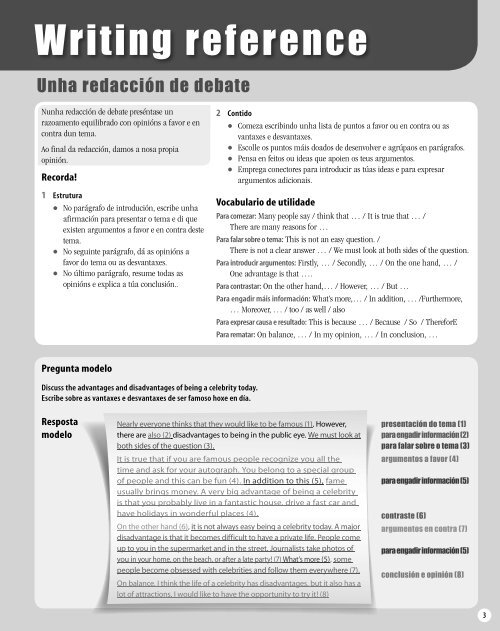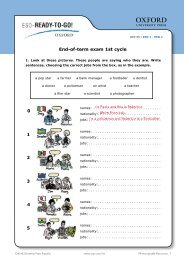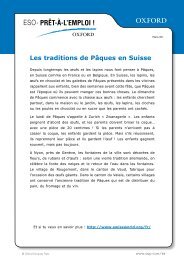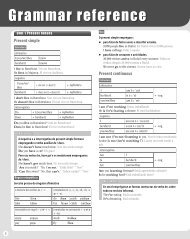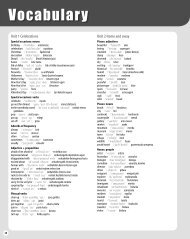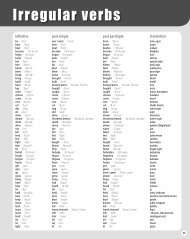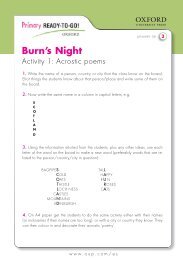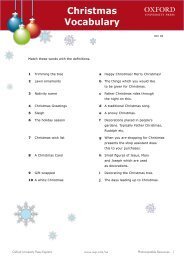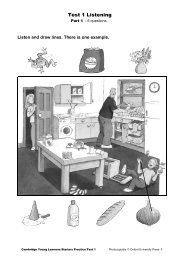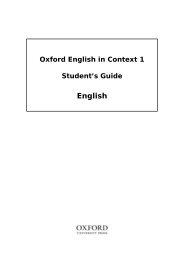cubierta in context gallego2 .indd
cubierta in context gallego2 .indd
cubierta in context gallego2 .indd
Create successful ePaper yourself
Turn your PDF publications into a flip-book with our unique Google optimized e-Paper software.
Writ<strong>in</strong>g reference<br />
Unha redacción de debate<br />
Nunha redacción de debate preséntase un<br />
razoamento equilibrado con op<strong>in</strong>ións a favor e en<br />
contra dun tema.<br />
Ao f<strong>in</strong>al da redacción, damos a nosa propia<br />
op<strong>in</strong>ión.<br />
Recorda!<br />
1 Estrutura<br />
• No parágrafo de <strong>in</strong>trodución, escribe unha<br />
afirmación para presentar o tema e di que<br />
existen argumentos a favor e en contra deste<br />
tema.<br />
• No segu<strong>in</strong>te parágrafo, dá as op<strong>in</strong>ións a<br />
favor do tema ou as desvantaxes.<br />
• No último parágrafo, resume todas as<br />
op<strong>in</strong>ións e explica a túa conclusión..<br />
2 Contido<br />
• Comeza escrib<strong>in</strong>do unha lista de puntos a favor ou en contra ou as<br />
vantaxes e desvantaxes.<br />
Escolle os puntos máis doados de desenvolver e agrúpaos en parágrafos.<br />
Pensa en feitos ou ideas que apoien os teus argumentos.<br />
• Emprega conectores para <strong>in</strong>troducir as túas ideas e para expresar<br />
argumentos adicionais.<br />
Vocabulario de utilidade<br />
Para comezar: Many people say / th<strong>in</strong>k that … / It is true that … /<br />
There are many reasons for …<br />
Para falar sobre o tema: This is not an easy question. /<br />
There is not a clear answer … / We must look at both sides of the question.<br />
Para <strong>in</strong>troducir argumentos: Firstly, … / Secondly, … / On the one hand, … /<br />
One advantage is that ….<br />
Para contrastar: On the other hand,… / However, … / But …<br />
Para engadir máis <strong>in</strong>formación: What’s more,… / In addition, … /Furthermore,<br />
… Moreover, … / too / as well / also<br />
Para expresar causa e resultado: This is because … / Because / So / ThereforE<br />
Para rematar: On balance, … / In my op<strong>in</strong>ion, … / In conclusion, …<br />
Pregunta modelo<br />
Discuss the advantages and disadvantages of be<strong>in</strong>g a celebrity today.<br />
Escribe sobre as vantaxes e desvantaxes de ser famoso hoxe en día.<br />
Resposta<br />
modelo<br />
Nearly everyone th<strong>in</strong>ks that they would like to be famous (1). However,<br />
there are also (2) disadvantages to be<strong>in</strong>g <strong>in</strong> the public eye. We must look at<br />
both sides of the question (3).<br />
It is true that if you are famous people recognize you all the<br />
time and ask for your autograph. You belong to a special group<br />
of people and this can be fun (4). In addition to this (5), fame<br />
usually br<strong>in</strong>gs money. A very big advantage of be<strong>in</strong>g a celebrity<br />
is that you probably live <strong>in</strong> a fantastic house, drive a fast car and<br />
have holidays <strong>in</strong> wonderful places (4).<br />
On the other hand (6), it is not always easy be<strong>in</strong>g a celebrity today. A major<br />
disadvantage is that it becomes difficult to have a private life. People come<br />
up to you <strong>in</strong> the supermarket and <strong>in</strong> the street. Journalists take photos of<br />
you <strong>in</strong> your home, on the beach, or after a late party! (7) What’s more (5), some<br />
people become obsessed with celebrities and follow them everywhere (7).<br />
On balance, I th<strong>in</strong>k the life of a celebrity has disadvantages, but it also has a<br />
lot of attractions. I would like to have the opportunity to try it! (8)<br />
presentación do tema (1)<br />
para engadir <strong>in</strong>formación (2)<br />
para falar sobre o tema (3)<br />
argumentos a favor (4)<br />
para engadir <strong>in</strong>formación (5)<br />
contraste (6)<br />
argumentos en contra (7)<br />
para engadir <strong>in</strong>formación (5)<br />
conclusión e op<strong>in</strong>ión (8)<br />
3
Un diálogo<br />
Un diálogo é unha conversa entre dúas ou máis<br />
persoas.<br />
Cando escribimos un diálogo, temos que deixar<br />
clara a súa función, por exemplo, explicar / dar<br />
noticias.<br />
Recorda!<br />
1 Estrutura<br />
• Un diálogo ten:<br />
- un pr<strong>in</strong>cipio (para deixar clara a<br />
función da conversa)<br />
- un nó (o <strong>in</strong>tercambio pr<strong>in</strong>cipal)<br />
- un f<strong>in</strong>al (a conclusión)<br />
• Organiza o diálogo claramente para que<br />
o lector poida ver facilmente quen está<br />
falando.<br />
2 Contido<br />
Pensa nos personaxes e no que dirían e farían.<br />
• Emprega l<strong>in</strong>guaxe natural e <strong>in</strong>formal, e <strong>in</strong>clúe expresións coloquiais,<br />
contraccións, expresións de recheo, verbos con partículas e respostas<br />
curtas.<br />
Vocabulario de utilidade<br />
Saúdos: Hi! / How are you? / How’s life? / How are th<strong>in</strong>gs? / F<strong>in</strong>e. / Great. /<br />
Not bad, thanks.<br />
Verbos con partículas: pick up / put off / drop <strong>in</strong> / pop round / look forward to<br />
Expresións coloquiais: Hiya! / What’s up? / Cool! / Sure. / Sounds good. /<br />
You’re kidd<strong>in</strong>g! / Do you fancy …? / Hang on! / OK.<br />
Expresións de recheo: erm… / umm … / look, … / oh, … / well, …<br />
Despedidas: Great to see you. / See you soon. / Say ‘Hi!’ to… for me. /<br />
I’ll be <strong>in</strong> touch. / Bye.<br />
Pregunta modelo<br />
Write a telephone conversation between two friends mak<strong>in</strong>g arrangements to go to the beach.<br />
Escribe unha conversa telefónica entre dous amigos que fan plans para iren á praia.<br />
Resposta modelo Becky Hello (1). saúdos (1)<br />
Trish Hi (1) Becky! It’s me (1).<br />
Becky Trish, hi! How are th<strong>in</strong>gs? (1)<br />
Trish OK. But I’m (2) so bored. I really want to go contracción (2)<br />
out somewhere and do someth<strong>in</strong>g. Listen (3), are you expresións de recheo (3)<br />
do<strong>in</strong>g anyth<strong>in</strong>g this afternoon?<br />
Becky Nope (4). I’m bored too. There’s no one at expresión coloquial (4)<br />
home, noth<strong>in</strong>g on TV, and I’ve f<strong>in</strong>ished<br />
all my homework. So, where do you want to go?<br />
Trish Do you fancy go<strong>in</strong>g (4) to the beach? We could give expresión coloquial (4)<br />
Ben and Jim a r<strong>in</strong>g and f<strong>in</strong>d out if they want to<br />
come. Ben’s got (2) his dad’s car for the weekend too! contracción (2)<br />
Becky Great idea! We could take a picnic and the<br />
volleyball th<strong>in</strong>gs.<br />
Trish Cool! (4) I’ll phone Ben and Jim and expresión coloquial (4)<br />
we’ll pick you up (5) <strong>in</strong> half an hour. verbo con partículas (5)<br />
Becky Sounds good (4). I’ll make some sandwiches. And expresión coloquial (4)<br />
don’t (2) forget the suncream! contracción (2)<br />
Trish I won’t! (6) And remember – Ben is a vegetarian! resposta curta (6)<br />
Becky OK. See you <strong>in</strong> half an hour (7). despedida (7)<br />
Trish See you (7).<br />
4
Unha narración<br />
Nunha narración, contamos unha historia ou un acontecemento.<br />
A historia pode ser real ou imax<strong>in</strong>aria.<br />
Normalmente, úsanse tempos pasados.<br />
Recorda!<br />
1 Estrutura<br />
• A historia debe ter un pr<strong>in</strong>cipio, un nó e un f<strong>in</strong>al moi<br />
claros.<br />
2 Contido<br />
• Fai que a historia sexa o máis <strong>in</strong>teresante e emocionante<br />
posible.<br />
Fala sobre o ambiente e as túas emocións.<br />
• Emprega unha variedade de verbos, adxectivos e adverbios<br />
para engadir <strong>in</strong>terese.<br />
Emprega diferentes tempos verbais pasados.<br />
• Emprega palabras para expresar a sucesión dos feitos e<br />
conectores para <strong>in</strong>dicar a orde dos acontecementos.<br />
Vocabulario de utilidade<br />
Para comezar: I had never been so excited / happy, etc. /<br />
It was the best / worst day of my life. / It was completely dark! /<br />
I will always remember … / One of my happiest /..<br />
worst memories...<br />
Expresións de tempo: one day, / last week, / two days ago /<br />
s<strong>in</strong>ce Monday / for a week / at midnight,<br />
Conectores de tempo: When … / As soon as … / While …<br />
Para expresar a sucesión dos feitos: Before … / At first, … / Later, … /<br />
Then … / After that, … / Afterwards, …<br />
Adverbios de modo: angrily / happily / quietly / suddenly<br />
Adverbios de grao: really / very / extremely<br />
Para facer comentarios con adverbios: amaz<strong>in</strong>gly / luckily /<br />
(un)fortunately<br />
Expresar emocións: surprised / excited / scared / lonely /<br />
worried / happy<br />
Para rematar: In the end,… / Never aga<strong>in</strong>! / What a/an …! /<br />
I hope someth<strong>in</strong>g like that never happens aga<strong>in</strong>!<br />
Pregunta modelo<br />
Write a story about someth<strong>in</strong>g frighten<strong>in</strong>g that happened on a journey.<br />
Escribe unha historia sobre algo aterrador que pasou nunha viaxe.<br />
Resposta modelo<br />
It was the most frighten<strong>in</strong>g moment of my life! (1) I was (2) comezo <strong>in</strong>teresante (1)<br />
late because I had overslept. I missed (2) my normal tra<strong>in</strong>, tempos pasados (2)<br />
so I took (2) the 10.00 tra<strong>in</strong> <strong>in</strong>stead. When (3) I got off (2) at conectores de tempo (3)<br />
Wyford, I stepped <strong>in</strong>to a real nightmare (4). ambiente (4)<br />
I knew (2) someth<strong>in</strong>g was (2) wrong as soon as (3) I started (2)<br />
walk<strong>in</strong>g along the platform. There was (2) a group of people stand<strong>in</strong>g<br />
very (5) still and look<strong>in</strong>g at someth<strong>in</strong>g or someone. When (5) adverbio de grao (5)<br />
I got (2) nearer, I saw (2) that a man and a woman were stand<strong>in</strong>g (2)<br />
outside the ticket office. The man was po<strong>in</strong>t<strong>in</strong>g (2) a gun at the<br />
woman. I was terrified! (6) sentimentos (6)<br />
It was so strange. Everyone stopped mov<strong>in</strong>g and watched<br />
the man. It was like a scene from a film (4)! Suddenly (7), two police ambiente (4)<br />
officers came up (2) beh<strong>in</strong>d the man and knocked (2) the gun adverbio de modo (5)<br />
out of his hand. Later (8), someone told (2) me that it wasn’t a real secuencia (6)<br />
gun, it was (2) a toy. The man had stolen (2) money from the<br />
ticket office and the woman had tried (2) to stop him.<br />
Fortunately (9), the man was caught and no one was hurt, but comentario con<br />
I hope that noth<strong>in</strong>g as frighten<strong>in</strong>g as this ever happens aga<strong>in</strong>! (10) adverbio (7)<br />
f<strong>in</strong>al (8)<br />
5
Un resumo<br />
Escribimos un resumo para transmitir as ideas<br />
pr<strong>in</strong>cipais dun texto en poucas frases.<br />
Recorda!<br />
• Inclúe soamente a <strong>in</strong>formación máis<br />
importante.<br />
• Non <strong>in</strong>clúas <strong>in</strong>formación que non é<br />
importante, como exemplos, detalles, discurso<br />
directo.<br />
• Emprega as túas propias palabras e non repitas<br />
expresións completas do texto.<br />
• Non deas a túa op<strong>in</strong>ión ou engadas<br />
<strong>in</strong>formación adicional.<br />
Para preparar<br />
• Le o texto rapidamente para procurar a<br />
<strong>in</strong>formación esencial.<br />
Volve ler o texto e subliña as tres ou catro ideas máis importantes.<br />
• Sen mirar de novo o texto, escribe catro ou c<strong>in</strong>co frases sobre el de<br />
memoria. Intenta empregar palabras diferentes.<br />
• Volve ler o texto e revisa o teu resumo. Asegúrate de que (a) <strong>in</strong>cluíches<br />
toda a <strong>in</strong>formación importante, (b) non copiaches do texto, (c)<br />
axustácheste ao número límite de palabras.<br />
• Se o resumo é demasiado longo, corta os detalles <strong>in</strong>necesarios.<br />
Vocabulario de utilidade<br />
Conectores (de contraste): In spite of… / Despite … / Although … / However, …<br />
Conectores (para engadir <strong>in</strong>formación): In addition, … / Both … / also / too<br />
Conectores (de causa e resultado): This is because … / Because … / So … /<br />
Therefore …<br />
Oracións subord<strong>in</strong>adas relativas: The film, which is about a safari, shows that … /<br />
The statement that he gave <strong>in</strong> March is no longer true …<br />
Pregunta modelo<br />
Summarize the follow<strong>in</strong>g article <strong>in</strong> fewer than 50 words.<br />
Fai un resumo deste artigo en menos de 50 palabras.<br />
The Island<br />
In recent years, we have seen significant developments<br />
<strong>in</strong> clon<strong>in</strong>g. Sheep, cows, cats and, more recently, dogs<br />
have all been cloned <strong>in</strong> the name of scientific progress.<br />
One of the potential uses of clon<strong>in</strong>g (1) is to ‘grow’ tema (1)<br />
replacement organs for people who are ill <strong>in</strong> human<br />
clones. It is this subject that is portrayed <strong>in</strong> a new film (1)<br />
released this week <strong>in</strong> the USA called ‘The Island’ (1).<br />
The film features Ewan McGregor and Scarlett Johanssen<br />
and it raises awareness of this highly controversial polémica (2)<br />
moral issue (2). However, <strong>in</strong> spite of excellent performances (3) boa <strong>in</strong>terpretación (3),<br />
from both ma<strong>in</strong> actors and spectacular special effects (3), bos efectos especiais<br />
the film received a disappo<strong>in</strong>t<strong>in</strong>g reaction from the<br />
non foi ben recibida<br />
American audiences (4). It is possible that the subject is too nos EEUU (4)<br />
difficult and that some audiences prefer their thrillers (5)<br />
razóns do seu pouco<br />
without the moral dilemmas (5). The film opens <strong>in</strong> the UK éxito (5)<br />
next week and it will be <strong>in</strong>terest<strong>in</strong>g to see how the<br />
British audiences react.<br />
Resposta modelo<br />
The new film ‘The Island’, which deals with the<br />
controversial subject of clon<strong>in</strong>g people, has not been<br />
received well <strong>in</strong> the USA. Although the act<strong>in</strong>g and<br />
effects are very good, some audiences may have<br />
been put off by the moral message of the film.<br />
6
Unha redacción de op<strong>in</strong>ión<br />
Escribimos unha redacción de op<strong>in</strong>ión para dicir o que<br />
pensamos sobre un tema.<br />
Soamente expresamos a nosa op<strong>in</strong>ión, non <strong>in</strong>cluímos outros<br />
puntos de vista.<br />
Recorda!<br />
1 Estrutura<br />
• No parágrafo de <strong>in</strong>trodución, explica o tema e dá a túa<br />
op<strong>in</strong>ión sobre el.<br />
• Nos segu<strong>in</strong>tes dous ou tres parágrafos, dá argumentos<br />
para apoiar a túa op<strong>in</strong>ión.<br />
No último parágrafo, resume a túa op<strong>in</strong>ión.<br />
• Comeza cada parágrafo cunha frase sobre o tema e<br />
resume as túas ideas pr<strong>in</strong>cipais.<br />
2 Contido<br />
Inclúe feitos e exemplos s<strong>in</strong>xelos para apoiar as túas ideas.<br />
• Non escribas sobre as vantaxes e desvantaxes ou os<br />
argumentos a favor ou en contra.<br />
Vocabulario de utilidade<br />
Para dar unha op<strong>in</strong>ión: In my op<strong>in</strong>ion, … / Personally, I th<strong>in</strong>k /<br />
I believe that … / I feel very strongly that … /<br />
To my m<strong>in</strong>d, … / I (completely) agree/disagree with … /<br />
It seems to me that …<br />
Para explicar feitos: It is a fact that … /<br />
It is widely known that … / There is/are def<strong>in</strong>itely… /<br />
It is true that …<br />
Para referirse ás ideas doutras persoas: Many people<br />
say/believe that …<br />
Para expresar causa e resultado: This is because … /<br />
As a result, … / Therefore … / My ma<strong>in</strong> reason is … /<br />
Another reason is …<br />
Para engadir <strong>in</strong>formación: What’s more, … / In addition, … /<br />
Furthermore, … / Moreover, … / too / as well / also<br />
Para rematar: To sum up, … / To conclude, … /<br />
In conclusion, … / It is clear that …<br />
Pregunta modelo<br />
‘Life is more stressful today than <strong>in</strong> the past.’ Do you agree?<br />
‘A vida é máis estresante hoxe en día ca no pasado.’ Estás de acordo?<br />
Resposta modelo<br />
Many people believe that life today is more stressful than para explicar o tema (1)<br />
ever before, but is this really true? (1) In my op<strong>in</strong>ion (2), there para dar a túa op<strong>in</strong>ión (2)<br />
has always been stress <strong>in</strong> people’s lives, but the type of<br />
stress has changed.<br />
In the past, people were stressed as a result of (3) different para expresar a causa (3)<br />
th<strong>in</strong>gs. It is a fact that (4) many people had large families and para explicar feitos (4)<br />
little money. In addition (5), people has less health care than para engadir <strong>in</strong>formación (5)<br />
they do today. People had to work very long hours and they<br />
often had no holidays. To my m<strong>in</strong>d (2), this implies that life was para dar a túa op<strong>in</strong>ión (2)<br />
extremely stressful <strong>in</strong> the past.<br />
Today, technology has made our lives easier. However (6), I para expresar contraste (6)<br />
th<strong>in</strong>k that (2) it has also brought a different stress <strong>in</strong>to our lives. para dar a túa op<strong>in</strong>ión (2)<br />
Because of (7) technology, life has become faster and faster. para dar razóns (7)<br />
We are never alone and we are always rush<strong>in</strong>g somewhere.<br />
The world is a very busy and noisy place.<br />
In conclusion, although I agree that modern life is stressful, para rematar (8)<br />
I also th<strong>in</strong>k that people <strong>in</strong> the past faced many problems (8).<br />
To my m<strong>in</strong>d, life is not more stressful today, the stress para resumir a túa op<strong>in</strong>ión (9)<br />
is just different (9).<br />
7
Unha biografía<br />
Unha biografía é un resumo da vida dunha<br />
persoa, que <strong>in</strong>clúe os feitos máis importantes ou<br />
<strong>in</strong>teresantes.<br />
Comeza co nacemento da persoa e cont<strong>in</strong>úa ata a<br />
súa morte ou ata o presente.<br />
Recorda!<br />
1 Estrutura<br />
• No parágrafo de <strong>in</strong>trodución, di por que a<br />
persoa é famosa / importante. Dá detalles<br />
sobre o seu nacemento / <strong>in</strong>fancia.<br />
• No segu<strong>in</strong>te parágrafo, dá detalles sobre a<br />
vida e a profesión da persoa.<br />
• No último parágrafo, explica o que a persoa<br />
fai agora / no f<strong>in</strong>al da súa vida. Dá a túa<br />
op<strong>in</strong>ión sobre a importancia da persoa hoxe<br />
en día.<br />
2 Contido<br />
• Emprega os tempos pasados sobre alguén que morreu e os tempos<br />
presentes e o pretérito perfecto para escribir sobre alguén que aínda está<br />
vivo.<br />
• Emprega palabras para expresar a sucesión dos feitos para deixar clara a<br />
orde de eventos.<br />
• Emprega adxectivos do carácter para describir a persoa.<br />
Vocabulario de utilidade<br />
Etapas da vida: … was born on/<strong>in</strong> … / At an early age … /<br />
His/her early life was… / He/She was educated at / grew up <strong>in</strong> … /<br />
He/She lived <strong>in</strong> … / spent …years / retired <strong>in</strong> … / died <strong>in</strong>…<br />
Para expresar a sucesión dos feitos: At first, … / After / Afterwards, … /<br />
Later, … / Then, … / F<strong>in</strong>ally,… / In the end, … / <strong>in</strong> 1986<br />
Para engadir <strong>in</strong>formación:Not only … / but also … / He/She both … and …<br />
Para expresar resultado: As a result of this, … / Consequently, … /<br />
Because of this …<br />
Adxectivos de carácter: famous / imag<strong>in</strong>ative / talented / brilliant / exceptional<br />
/ creative / <strong>in</strong>fluential / popular / <strong>in</strong>spir<strong>in</strong>g / successful / well-known<br />
Pregunta modelo<br />
Write about a person from the fashion <strong>in</strong>dustry who you admire. Why do you admire this person?<br />
Escribe sobre unha persoa do mundo da moda á que admires. Por que admiras esta persoa?<br />
Resposta modelo<br />
Jan Carstairs was born (1) <strong>in</strong> London <strong>in</strong> 1945 and she became etapas da vida (1)<br />
<strong>in</strong>terested (1) <strong>in</strong> art and design at an early age (1). By the 1960s,<br />
Jan had become one of the most <strong>in</strong>fluential designers (2) of importancia (2)<br />
the 1960s and her clothes were worn by the top models (2) of<br />
the time.<br />
Jan came from quite a poor family but she won a scholarship (1)<br />
to a famous London art college <strong>in</strong> 1959 (3). Four years later (3), para expresar a sucesión de<br />
she was design<strong>in</strong>g the m<strong>in</strong>i skirts and paper dresses that los feitos (3)<br />
appeared on the covers of the most popular magaz<strong>in</strong>es<br />
of the ’60s. adxectivos de carácter (4)<br />
Jan was brilliant (4) but very shy (4). Because of this (5), she avoided resultado (5)<br />
publicity and <strong>in</strong> 1974 (3) she moved to a small town <strong>in</strong> France<br />
where she lived until she died <strong>in</strong> 2004 (1). Jan Carstairs was an<br />
exceptionally talented (6) designer and is still remembered (6) op<strong>in</strong>ión e importancia hoxe<br />
and copied (6) by fashion designers today (6). en día (6)<br />
8
Unha descrición dunha persoa<br />
Cando se escribe a descrición dunha persoa,<br />
<strong>in</strong>fórmase o lector sobre a súa aparencia física e<br />
carácter.<br />
Tamén podemos dicir o que nós ou outras<br />
persoas op<strong>in</strong>an desa persoa.<br />
Podemos describir a alguén que coñecemos ou a<br />
unha persoa famosa.<br />
Recorda!<br />
1 Estrutura<br />
• No primeiro parágrafo, presenta a persoa e<br />
describe a súa aparencia física.<br />
• No segu<strong>in</strong>te parágrafo, describe a<br />
personalidade da persoa (características<br />
negativas e positivas).<br />
• No último parágrafo, dá a túa op<strong>in</strong>ión sobre<br />
a persoa e razóaa.<br />
2 Contido<br />
• Usa os tempos presentes para escribir sobre alguén que coñeces no presente e<br />
os tempos pasados para escribir sobre alguén do pasado.<br />
• Dá exemplos de cousas que fai esa persoa e que demostran a súa<br />
personalidade.<br />
• Usa unha variedade de adxectivos, adverbios e modificadores para engadir<br />
<strong>in</strong>terese.<br />
• Usa modismos ou símiles para engadirlle <strong>in</strong>terese á túa descrición.<br />
Vocabulario de utilidade<br />
Idade: 20 years old / about 20 / <strong>in</strong> his/her twenties / elderly<br />
Aparencia física: tall / short / slim / dark hair / fair hair / blue eyes / pretty /<br />
handsome / good-look<strong>in</strong>g / looks/looked like …<br />
Roupa: wears/wore colourful clothes / a lot of jewellery / glasses<br />
Personalidade: quiet / <strong>in</strong>telligent / k<strong>in</strong>d / shy / funny / outgo<strong>in</strong>g / patient /<br />
friendly / honest / chatty<br />
Símiles e modismos: as quiet as a mouse / as gentle as a lamb /<br />
a heart of gold / is a pa<strong>in</strong> <strong>in</strong> the neck<br />
Modificadores: a bit / quite / a little / slightly / extremely / very / really<br />
Adverbios de frecuencia: always /usually / often /sometimes /never /occasionally<br />
Pregunta modelo<br />
Write a description of someone <strong>in</strong> your family that you admire.<br />
Escribe unha descrición de alguén da túa familia a quen admires.<br />
Resposta modelo<br />
The person I admire most <strong>in</strong> my family is my grandmother, <strong>in</strong>trodución (1)<br />
Granny Em (1). Granny Em has f<strong>in</strong>e, white hair and bright, aparencia física (2)<br />
blue eyes (2). She’s as strong as an ox (3) and she refuses to símil (3)<br />
slow down! She is eighty now, but she’s really (4) fit for her modificador (4)<br />
age and she is still extremely (4) active. Every day, she<br />
visits a rest home for elderly people to help them (5) and evidencia (5)<br />
have a chat. Most of them are younger than she is!<br />
Granny Em is a determ<strong>in</strong>ed (6) old lady, but she is k<strong>in</strong>d (6), personalidade (6)<br />
gentle and understand<strong>in</strong>g (6) too. She has had a difficult<br />
life and has learned a lot of th<strong>in</strong>gs. That is why she’s<br />
the person I go to when I have problems, and she<br />
always gives great advice.<br />
Granny Em has a very big family and we all love and op<strong>in</strong>ións razoadas (7)<br />
respect (7) her. In my op<strong>in</strong>ion (7), but she has a heart of gold (8) modismo (8)<br />
and she cont<strong>in</strong>ues to make a difference to our lives (7).<br />
9
Unha carta formal<br />
En cartas formais, escribimos a organizacións<br />
(ofic<strong>in</strong>as, universidades, negocios, etc.) ou a persoas<br />
que non coñecemos moi ben.<br />
Podemos escribir para pedir <strong>in</strong>formación, solicitar<br />
traballo ou poñer unha queixa, etc.<br />
Recorda!<br />
1 Esquema<br />
• Escribe o teu enderezo na parte superior<br />
dereita da páx<strong>in</strong>a e o enderezo da persoa /<br />
empresa á que lle estás escrib<strong>in</strong>do na parte<br />
esquerda.<br />
Escribe a data debaixo do teu enderezo.<br />
• Deixa unha liña baleira entre o enderezo do<br />
dest<strong>in</strong>atario e o saúdo.<br />
• Escribe o teu nome debaixo da túa s<strong>in</strong>atura.<br />
2 Estilo e contido<br />
Usa vocabulario e frases formais.<br />
• Non uses contraccións.<br />
Non uses l<strong>in</strong>guaxe coloquial.<br />
•<br />
Usa as expresións correctas no saúdo e na despedida.<br />
Explica claramente a razón pola que escribes.<br />
Emprega conectores para enlazar as ideas.<br />
Vocabulario de utilidade<br />
Saúdos: Dear Mr / Ms (Lee), (se sabes o nome) / Dear Sir or Madam, (se non<br />
sabes o nome).<br />
Razón pola que escribes a carta: I am writ<strong>in</strong>g to apply for … /<br />
request some <strong>in</strong>formation about … / ask about … / compla<strong>in</strong> about … /<br />
I saw your advertisement <strong>in</strong> … / I read about … / Regard<strong>in</strong>g …<br />
Para expresar a sucesión dos feitos: Firstly, … / Secondly, … / F<strong>in</strong>ally, … /<br />
In conclusion …<br />
L<strong>in</strong>guaxe formal: I would like to po<strong>in</strong>t out that, … / I would be grateful if you<br />
could … / Could you possibly …? / I am afraid I …<br />
Para achegar documentos: I enclose my most recent CV. / a stamped addressed<br />
envelope.<br />
Para rematar: I look forward to hear<strong>in</strong>g from you. / Yours faithfully, (con Dear<br />
Sir or Madam) / Yours s<strong>in</strong>cerely, (con Dear Mr/Ms (Lee))<br />
Pregunta modelo<br />
You want to enter the competition ‘Young Journalist of the Year’. Write to ‘The Competitions Department’<br />
of ‘Young News Magaz<strong>in</strong>e’ to ask for more <strong>in</strong>formation.<br />
Queres participar no concurso ‘Xornalista mozo do ano’. Escríbelle ao ‘Departamento de concursos’ da ‘Revista mozo de novas’ para pedir<br />
máis <strong>in</strong>formación.<br />
Resposta<br />
modelo<br />
19 Briar Road (1)<br />
Southampton<br />
Hampshire<br />
15th November 2006 (2)<br />
enderezo do remitente (1)<br />
data (2)<br />
Competitions Department (3)<br />
Young News Magaz<strong>in</strong>e<br />
118 High Street<br />
Leeds<br />
Dear Sir or Madam (4),<br />
I read about (5) the competition for ‘Young Journalist of the Year’ on your<br />
website and I am writ<strong>in</strong>g to ask for (5) some more <strong>in</strong>formation.<br />
Firstly (6), I would be grateful if you could tell me (7) how long the article should<br />
be. Also, would it be acceptable (7) for me to enter an article that has already been<br />
published? Secondly (6), could you let me know (7) if I should send photographs<br />
with the article? F<strong>in</strong>ally (6), could you please (7) confirm the clos<strong>in</strong>g date of the<br />
competition?<br />
I look forward to hear<strong>in</strong>g from you (8).<br />
Yours faithfully (9),<br />
K.M.Newman (9)<br />
K.M.Newman (10)<br />
enderezo da compañía (3)<br />
saúdo (4)<br />
razón pola que se escribe (5)<br />
sucesión de feitos (6)<br />
l<strong>in</strong>guaxe formal (7)<br />
para rematar (8)<br />
s<strong>in</strong>atura (9)<br />
nome (10)<br />
10
Unha descrición dun lugar<br />
Podemos escribir unha descrición dun lugar especial, dun edificio, dunha<br />
cidade, dunha área, dun cuarto, etc.<br />
Podemos describir o aspecto do lugar, o seu ambiente, cousas que acontecen<br />
alí e por que nos gusta ou desgusta o devandito lugar.<br />
Recorda!<br />
1 Estrutura<br />
• No primeiro parágrafo, explica onde está o lugar e resume a razón<br />
pola que o escolliches.<br />
• No segu<strong>in</strong>te parágrafo ou parágrafos, dá máis <strong>in</strong>formación sobre o<br />
lugar, tanto xeral coma específica. Pensa sobre o que se ve / fai /ole /<br />
oe alí. Como te fai sentir?<br />
• No último parágrafo, di por que a ti / outra xente lle gusta / non lle<br />
gusta o lugar.<br />
2 Contido<br />
Dá exemplos das cousas / persoas que hai nese lugar.<br />
Explica por que o lugar é <strong>in</strong>teresante ou importante.<br />
• Emprega dist<strong>in</strong>tos tipos de adxectivos para describir tamaño / aspecto<br />
/ ambiente.<br />
Vocabulario de utilidade<br />
Localización: only ten m<strong>in</strong>utes from where I live /<br />
very close to … / <strong>in</strong> the town centre /<br />
on the south coast of… / opposite / next to /<br />
near<br />
Comparativos e superlativos: the best/most popular /<br />
most <strong>in</strong>terest<strong>in</strong>g / busier than … /<br />
not as … as …<br />
Para dar razóns: What I like about … is … /<br />
The ma<strong>in</strong> reason I like … is … / because …<br />
Adxectivos: huge / t<strong>in</strong>y / modern / traditional /<br />
peaceful / busy / crowded / <strong>in</strong>terest<strong>in</strong>g /<br />
historical<br />
Nomes: architecture / design / layout / history /<br />
facilities / build<strong>in</strong>gs<br />
Para facer unha recomendación: This is a build<strong>in</strong>g<br />
every tourist should see. / I would recommend<br />
a visit to … / If you’re look<strong>in</strong>g for a …,<br />
don’t miss …<br />
Pregunta modelo<br />
Describe an <strong>in</strong>terest<strong>in</strong>g place to visit <strong>in</strong> your town. Why do you like it?<br />
Describe un lugar <strong>in</strong>teresante para visitar na túa cidade. Por que che gusta?<br />
Resposta modelo<br />
If you visit my town, you must go to the Five Ways lugar (1)<br />
Hotel (1). It’s <strong>in</strong> the centre (2) of the town and it is one of localización (2)<br />
the oldest and most <strong>in</strong>terest<strong>in</strong>g build<strong>in</strong>gs <strong>in</strong> the area. It<br />
is also famous all over the country for its restaurant, (3) razón (3)<br />
where they serve traditional food cooked <strong>in</strong> the orig<strong>in</strong>al<br />
style.<br />
The Five Ways is a small (4) build<strong>in</strong>g, but you can’t miss it. adxectivos (4)<br />
The walls are covered with lovely (4) climb<strong>in</strong>g plants and<br />
the t<strong>in</strong>y (4) w<strong>in</strong>dows make the rooms quite dark (4). It feels very sentimentos (5)<br />
safe and secure! (5) It was built hundreds of years ago (6), when historia (6)<br />
people who were travell<strong>in</strong>g to London stopped here for función (7)<br />
food and rest (7). It was very popular because of the five<br />
roads that met here.<br />
Today, the small rooms have newer (8) furniture and the comparativo /<br />
kitchen has the latest (8) equipment, but the walls are superlativo (8)<br />
orig<strong>in</strong>al(5) and you can walk on the same floors as<br />
people did centuries ago.<br />
For me (9), this is an amaz<strong>in</strong>g place and for anyone op<strong>in</strong>ión (9)<br />
<strong>in</strong>terested <strong>in</strong> history and good food I thoroughly recomendación (10)<br />
recommend a visit (10).<br />
11


